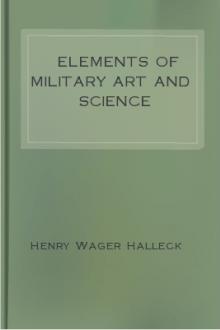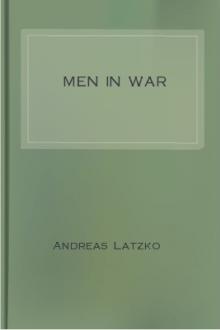Elements of Military Art and Science by Henry Wager Halleck (books you have to read txt) 📕

- Author: Henry Wager Halleck
- Performer: -
Book online «Elements of Military Art and Science by Henry Wager Halleck (books you have to read txt) 📕». Author Henry Wager Halleck
This subject will be alluded to again in the Notes on Sea-coast Defences, and Permanent Fortifications.
NOTE TO CHAPTER IV.—LOGISTICS.
The war in Mexico exhibited, in a striking manner, our superiority over the enemy in this branch of the military art. No army was better supplied than ours in all matters of subsistence, clothing, medical and hospital stores, and in means of transportation. Two points, however, are worthy of remark in this connection: 1st. The great waste of material, which resulted from the employment of raw troops under short enlistments, and commanded by officers appointed from civil life, who were without experience and destitute of military instruction; and, 2d. The immense expense of transportation, which was due in part to the above cause and in part to the employment, in the administrative departments, of civilians who were utterly ignorant of the rules and routine of military service. This war was conducted on the system of magazines and provisions carried in the train of the army, or purchased of the inhabitants and regularly paid for, forced requisitions being seldom resorted to, and then in very moderate quantities. The wisdom of this plan was proved by the general good order and discipline of our troops, and the general good-will of the non-combatant inhabitants of the country which was passed over or occupied by the army.
The war in the Crimea proved most conclusively the vast superiority of the French administrative system over that of the English—of the military over a civil organization of the administrative corps of an army. The French troops before Sebastopol were regularly, cheaply, and abundantly supplied with every requisite of provisions, clothing, munitions, medical stores, military utensils, and hospital and camp equipages; while the English army, notwithstanding an immense expenditure of money, was often paralyzed in its operations by the want of proper military material, and not unfrequently was destitute of even the necessaries of life.
Instead of profiting by this lesson, the recent tendency of our own government has been (especially in supplying the army in Utah) to imitate the sad example of the English, and to convert the supplying of our armies into a system of political patronage to be used for party purposes. If fully carried out, it must necessarily result in the ruin of the army, the robbery of the treasury, and the utter corruption of the government.
NOTE TO CHAPTER V.—TACTICS.
The war in Mexico, from the small number of troops engaged, and the peculiar character of the ground in most cases, afforded but few opportunities for the display of that skill in the tactics of battle which has so often determined the victory upon the great fields of Europe. Nevertheless, the history of that war is not without useful lessons in the use which may be made of the several arms in the attack and defence of positions. The limit assigned to these Notes will admit of only a few brief remarks upon these battles.
The affairs of Palo Alto and Resaca de la Palma properly constitute only a single battle. In the first, which was virtually a cannonade, the lines were nearly parallel, and Arista's change of front to an oblique position during the engagement, was followed by a corresponding movement on the part of General Taylor. Being made sensible of the superiority of the American artillery, the Mexican general fell back upon the Ravine of Resaca de la Palma, drawing up his troops in a concave line to suit the physical character of the ground. The Americans attacked the whole line with skirmishers, and with dragoons supported by light artillery, and the charge of a heavy column of infantry decided the victory. General Taylor's operations at Monterey partook more of the nature of an attack upon an intrenched position than of a regular battle upon the field. No doubt Worth's movement to the right had an important influence in deciding the contest, but the separation of his column from the main body, by a distance of some five miles, was, to say the least, a most hazardous operation. The Mexicans, however, took no advantage of the opening to operate between the separate masses into which the American army was divided. The loss which the Mexicans inflicted upon us resulted more from the strength of their position than from any skilful use of their defensive works. In the battle of Buena Vista, the efforts of Santa Anna were principally directed to turning the American left. If he had concentrated his masses more upon the centre at the plateau, the success gained in the early part of the contest would probably have been decisive. The American right at La Angostura was made almost inaccessible by the deep ravines in its front, and the skilful use made of the artillery from this point enabled General Taylor to gain the victory, even after his left had been completely turned, and a portion of the volunteers had actually fled from the field.
The manner in which Scott handled his troops in the various battles on his line of march from Vera Cruz to the capital, proved him to be one of the best generals of the age. At Cerro Gordo he so completely turned Santa Anna's left as to cut off his line of retreat, and nearly destroyed his army, the general himself barely escaping capture. The turning of Valencia's position by the village of San Geronimo, at the battle of Contreras, and the charge by Riley's columns of infantry, were movements well planned and admirably executed, as were also the rapid pursuit of Santa Anna to Churubusco, and the flank and rear attacks by the brigades of Pierce and Shields. The victory of Molino del Rey was mostly won with the musket, without very material assistance from heavy artillery, and was one of the most brilliant but dearly bought achievements of the war. The assault upon Chapultepec was preceded by a long and heavy cannonade, which produced a decided moral effect upon the enemy and greatly facilitated the assault.
With respect to the battles of the Crimean war, only that of the Alma is subject to the tactical criticism of ordinary battles; those of Balaklava, Inkerman, and the Tchernaya, were of the nature of sorties made to prevent an assault of the unfinished works of defence, and to prolong the operations of the siege. They must therefore be judged as such, and not according to the ordinary rules applicable to contests in the open field. At the battle of the Alma the Russians were attacked in position, the two lines of battle being nearly parallel. According to the original plan of attack, the Turks and Bosquet's division was to turn the Russian left, while the main attack was made upon the centre. But, on account of the division of command in the allied army, there was no concert of action. The heavy column of Bosquet probably decided the victory, although the battle was general throughout the whole line. The English army advanced in columns of brigades at deploying distances, its right connected with the French, and its left protected by a line of skirmishers, of cavalry and horse artillery. With respect to the formation and use of troops in the other battles, it may be remarked that the charge of the English light cavalry at Balaklava was apparently without necessity or object, and led to its inevitable destruction. In the battle of Inkerman the Russians directed their main attack upon the English right and centre, with false attacks upon the French left and towards Balaklava. But these false attacks, as is usual in such cases, were not conducted with sufficient energy and decision, and Bosquet was thus enabled to perceive the real intentions of the enemy upon the English portion of the line and move to its assistance. Moreover, the main body of the Russians moved in too heavy and unwieldy masses, which exposed them to terrible losses, and rendered impossible a rapid and effective deployment of their numerical force. The same criticism is applicable to their formation at the battle of the Tehernaya.
NOTE TO CHAPTER VI.—MEANS OF NATIONAL DEFENCE.
On the invasion of Mexico by the United States, the former republic had a large army of tolerably good troops, though badly officered, still worse equipped, and almost destitute of proper military stores; but she was entirely wanting in two important elements of national defence—fortifications and a navy. Her weakness was shown by the rapid and easy conquest of almost the entire country.
We have already remarked that the fortifications of Russia confined the theatre of war to a single point of the Crimea, and limited the military operations of the allies to the prolonged and only partially successful siege of Sebastopol.
NOTE TO CHAPTER VII.—SEA-COAST DEFENCES.
Allusion has already been made to the weakness of Mexico, resulting from her want of sea-coast defences, as shown by the war between that republic and the United States. This would have been still more manifest had she possessed any thing like a commercial marine, exposed to capture by our naval forces. As it was, the Mexican war afforded not a single contest between ships and forts, no opposition being made to the occupation of Mexican ports by our naval force. The only coast defence, the castle of San Juan d'Ulica was not attacked, but after the bombardment and capture of Vera Cruz, it surrendered without a blow.
The Crimean war, on the contrary, exhibited in a most marked degree the importance of a well-fortified sea-coast. Notwithstanding the immense force of the combined fleets of England and France, no naval attack was made upon either Cronstadt or Sebastopol, and the large naval force of Russia proved utterly useless as a defence against a maritime descent. There was, indeed, a simulachre of a "naval cannonade" on the latter place on the 17th of October, 1854, intended as a diversion of the attention and strength of the garrison from the land side, where the real struggle for predominance was going on between the besieged and the besiegers. The inutility of this attempt was so manifest that no serious naval attack was undertaken, notwithstanding that the allies were ready to bring to bear upon the antiquated and ill-armed Russian works the most powerful naval armaments the world had ever seen.
The results of this "simulachre of a naval cannonade," as it has been called, is worthy of note. The details are taken from Major Barnard's able pamphlet on "The Dangers and Defences of New York," and Commander Dahlgren's interesting and valuable work on "Shells and Shell Guns."
"The allied fleet consisted of 14 French, 10 British, and 2 Turkish ships-of-the-line (some few of which had auxiliary steam power), and a number of side-wheel steamers to tow these; and carried in all about 2,500 guns. It was opposed by about 280 guns from the works. The fleet kept itself (in general) at a respectable distance (from 1500 to 2000 yards); too far to inflict any material injury with its armament (32-pounders, with a moderate proportion of 8-inch shell-guns) upon the works;—too far to receive much from the inefficient armament of the Russian works."
"The only exception to this remark applies to the detached English squadron under Sir Edmund Lyons, consisting of the Agamemnon, Sanspareil, London, Arethusa, and Albion, the first-named of which vessels took a position at 750 or 800 yards from Fort Constantine, while the others stretched along at about the same distance from Fort Constantine, the 'Wasp Tower,' and 'Telegraph Battery.' Dahlgren describes the result as follows:—"
"The Agamemnon was very seriously maltreated, though not to such an extent as to impair her power of battery or engine. She was on fire several times; was struck by 240 shot or shells; and, singular to say, only lost 29, while her second, just by, lost 70 men. The Albion suffered still more, and in an hour was





Comments (0)